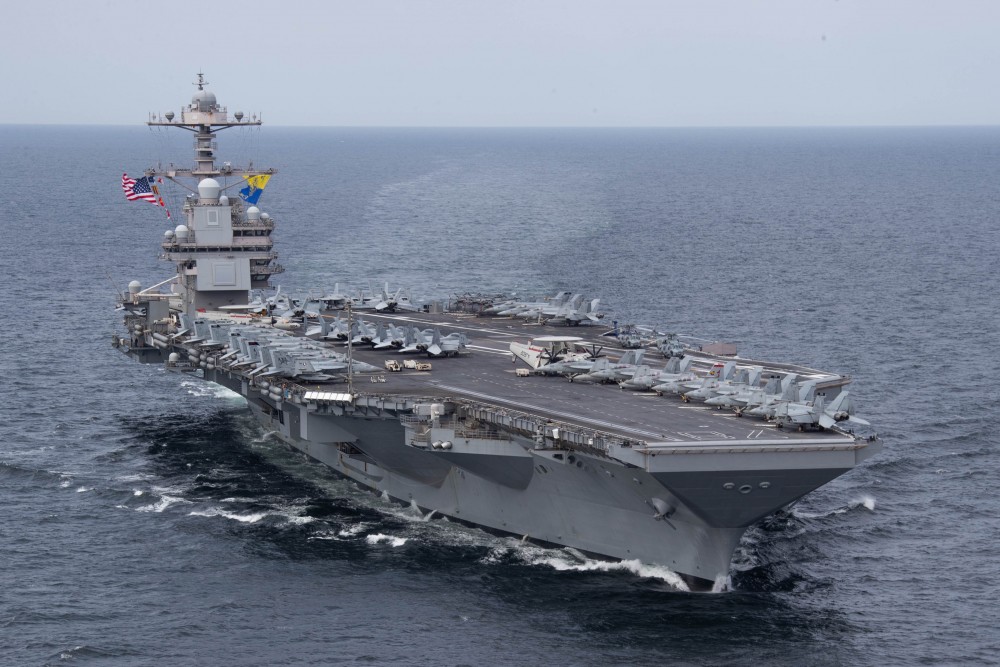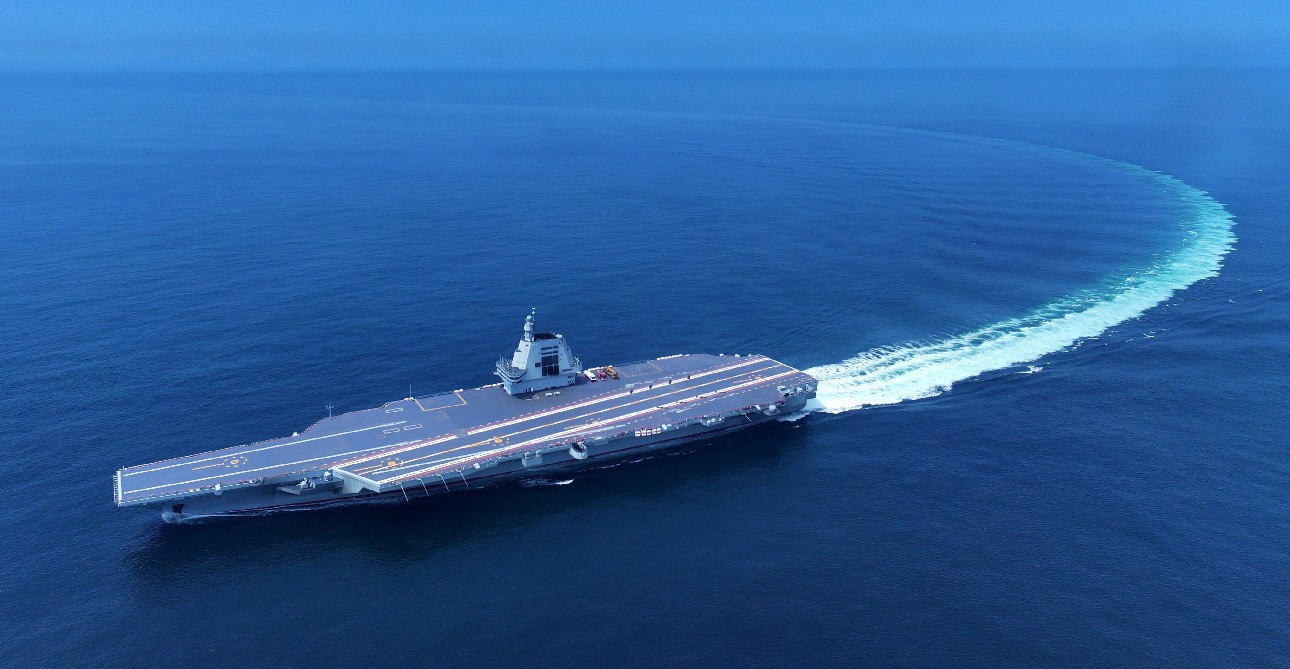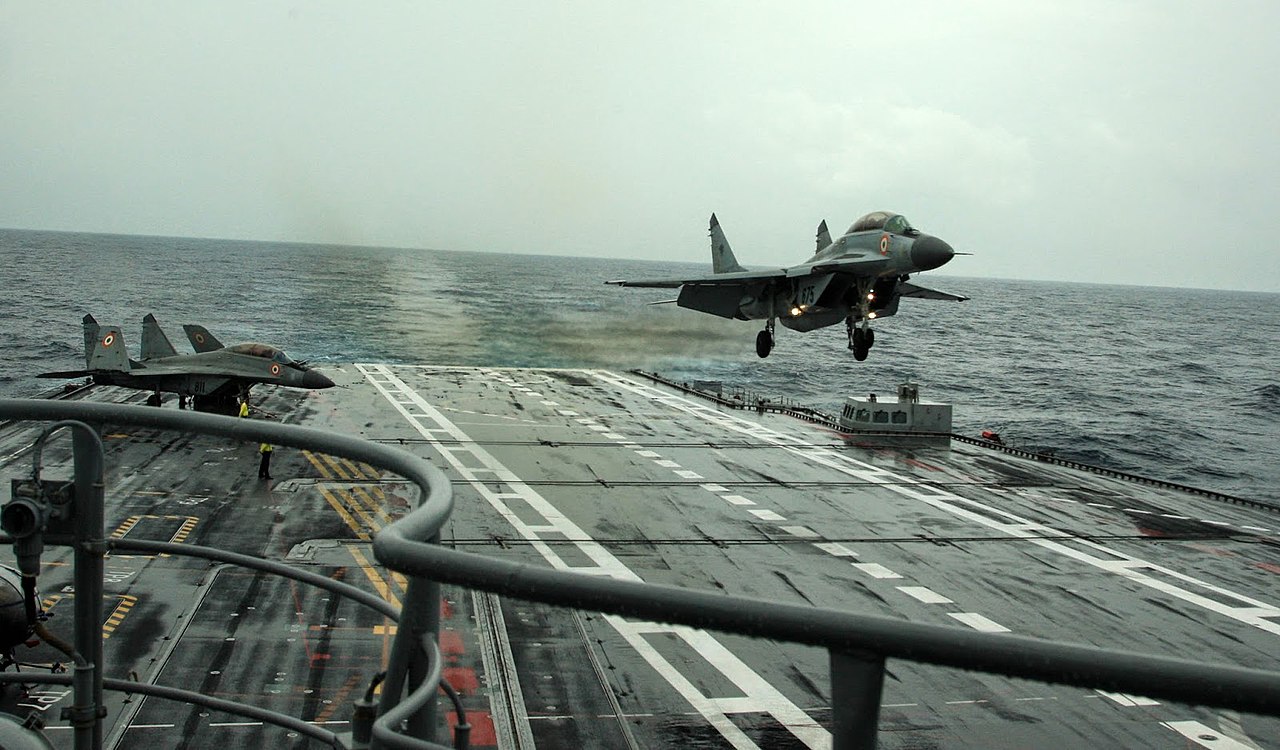Russia Plans 90-000-Ton ‘Super Carrier’ Armed With Naval Su-57 Stealth Fighters To Counter US Navy, Ex-Admiral Says

Boasting a powerful navy once, the Russian Navy trails the United States and China — two of the biggest naval powers in the world today – even as it currently chalks out plans to build a supercarrier and carrier-based advanced stealth fighters.
Former Deputy Chief of the Main Staff of the Russian Navy retired Vice Admiral Vladimir Pepelyaev, said that the Russian Navy should be able to build a promising aircraft carrier with a displacement of 70 to 90 thousand tons and station a naval variant of the Su-57 combat jet on it.
After retiring from his previous post, the Vice Admiral was tasked with developing an aircraft carrier at the Krylov Research Institute.
Sounding an optimistic note, he told Ria, “Our promising aircraft carrier should have a displacement of 70 to 90 thousand tons, but the most important thing is not the displacement, not air drones, but aircraft. Today, we have Su-33 and MiG-29K/Cube. In the future, our aircraft carrier should be armed with Su-57.”
AfriPrime App link: FREE to download...
https://www.amazon.com/Africircle-AfriPrime/dp/B0D2M3F2JT
The comments come in the backdrop of Russia’s Black Sea Fleet (BSF) receiving severe blows from persistent Ukrainian attacks. More than two years into the war, the BSF has lost some of the most advanced and oldest vessels to Ukraine’s Unmanned Aerial Vehicle (UAV) and Unmanned Surface Vessels (USV) attacks.
The need for an aircraft carrier goes beyond the number of other vessels the Russian Navy owns. As one of the greatest and most powerful military powers in the world, Russia does not have an aircraft carrier. In contrast, the United States has 11, and China has three.
Vice Admiral Pepelyaev has been vocal about the need for a carrier to combat threats at sea. He earlier asserted the need for Russia to maintain a strong naval presence in key regions and to project power globally. He also argued that aircraft carriers were essential for power projection and ensuring national security in an increasingly complex geopolitical landscape.
When asked about the number of aircraft carriers needed for the Russian Navy, the former vice admiral suggested that at least four aircraft carriers would be required: two for the Pacific Fleet and two for the Northern Fleet.
In January this year, Russian Navy Commander-in-Chief Admiral Nikolay Yevmenov said that the issue of the expediency of creating a prospective naval aircraft had been addressed. Its engagement will increase the effectiveness of various operational tasks.
That dream, however, appears far-fetched as the Russian defense industry remains stretched in a war economy and crushed under international sanctions. An ambitious carrier project was revealed in 2017, but there has been no meaningful progress on it, and if reports are anything to go by, it is still a work in progress.
Russia’s Supercarrier Dream Has Slowed Down?
Russia has one aircraft carrier, the Admiral Kuznetsov, which entered service in 1991. Throughout its operational history, the carrier has encountered numerous issues.
Even if the Kuznetsov survives its scheduled sea trials, outfitting the ship with a fully operational air wing will likely remain a huge undertaking for Russia. The carrier has only made one combat deployment in its nearly 30-year lifespan.
The return of Russia’s sole aircraft carrier would be a milestone. Last July, reports indicated that the Kuznetsov could start sea trials by the spring of 2024 and enter service by year-end. However, that timeline appears to have been pushed further.
AfriPrime App link: FREE to download...
https://www.amazon.com/Africircle-AfriPrime/dp/B0D2M3F2JT
Several military analysts have explained that Russia has boasted of a powerful navy since the Cold War era. It spent money on submarines, destroyers, frigates, and cruisers, all of which contributed to making Russia a formidable naval power. Moscow has the most diverse submarine fleet in the world. As a crucial component of its strategic deterrent, it believes some of these submarines are capable of launching ballistic missiles with nuclear warheads.
Russia, however, has continued to struggle with what are recognized as instruments of global power projection: aircraft carriers.

Critics of Russia’s military have observed that while it possesses a sizable fleet of “global navy” ships with strong offensive capabilities, it lacks aircraft carriers and, consequently, the ability to project power. Some analysts have reckoned that even Kuznetsov was designed primarily for coastal defense and lacked a nuclear power plant. So, it requires a lot of assistance to move between theaters.
In 2017, Moscow unveiled plans to build the “biggest aircraft carrier in the world” in what was seen as a bid to compete with the US’s Nimitz-class aircraft carriers. The Russian carrier concept dubbed the “Shtorm,” would be roughly the same size as the carriers that the US operates, displacing 100,000 tons and accommodating the same number of aircraft.
In contrast to Russian plans, the US has already developed and commissioned the world’s largest aircraft carrier: the USS Gerald R. Ford. It is the world’s largest warship and boasts exceptional dimensions, measuring 1,092 feet (333 meters) in length, with a beam of 256 feet (78 meters) at its flight deck and a height of 250 feet (76 meters). Incidentally, it has the displacement of 100,000 tons that Russia has been aspiring for.
Even China, which is considerably new to aircraft carrier building, has built a supercarrier of its own. Its ‘Fujian’ is comparable to the US Gerald R. Ford and has a displacement of about 80,000-85,000 tons. The Chinese carrier is conventionally powered but is the country’s first supercarrier and the first domestically developed carrier equipped with electromagnetic catapults and arresting devices.

The Russian Navy’s inability to deploy an operational aircraft carrier has been viewed as a fundamental shortcoming by its Western critics. The struggle with aircraft carriers has also meant that Russia does not have an advanced carrier-capable aircraft. This is where Pepelyaev’s suggestion for a Su-57 naval variant comes into the picture.
Stealth Carrier Fighters
The ex-deputy Chief of the General Staff of the Russian Navy revealed plans earlier this year to develop a naval variant of the Su-57 fighter jet for future carrier-borne operations.
Russia has developed a few carrier-capable jets, but their effectiveness has proven restricted. The Yak-38, for instance, was introduced in the mid-1970s as the first carrier jet for its Kiev-class carriers.
It had a lower payload, range, and speed than aircraft from competitor militaries. Compared to NATO carrier aircraft, even the upgraded Yak-36M, which had twice the payload and a longer range, lacked power.
The Yak-36 was decommissioned following the disintegration of the Soviet Union. Then came the Su-33, based on the Su-27 fighters, which are still in service. The jet was an upgrade of the Yak-38, but it was not really successful. The Kuznetsov, smaller than US carriers, cannot carry many huge jets.
After the Su-33, the Russians revived the MiG-29K project and developed the carrier variant of combat-proven MiG-29s. More suitable for ground strikes than the Su-33, the MiG-29K could carry 9,900 pounds of ordnance and reach a maximum speed of nearly 1,300 mph. However, the jet has been involved in some crashes and technical problems. Russia’s primary carrier jets are the Su-33 and MiG-29, though they lack carriers.

The US already has several carrier-capable F-35 Lightning II aircraft that have become synonymous with its global power projection. As the former deputy naval chief reiterated, this has necessitated the development of a fifth-generation stealth carrier-capable aircraft in Russia.
Russia’s revelation of plans coincides with China’s development of the J-35 stealth fighter, a carrier-based variant of the FC-31 specifically designed for operations on Chinese aircraft carriers.
Despite positioning itself as a massive military power, as evidenced by Russian President Putin’s remarks on the country’s Navy Day last year, Russia lacks a critical capability that the US and China appear to be nearing.
AfriPrime App link: FREE to download...
- Questions and Answers
- Opinion
- Story/Motivational/Inspiring
- Technology
- Art
- Causes
- Crafts
- Dance
- Drinks
- Film/Movie
- Fitness
- Food
- Jocuri
- Gardening
- Health
- Home
- Literature
- Music
- Networking
- Alte
- Party
- Religion
- Shopping
- Sports
- Theater
- Wellness
- News
- Culture
- War machines and policy

